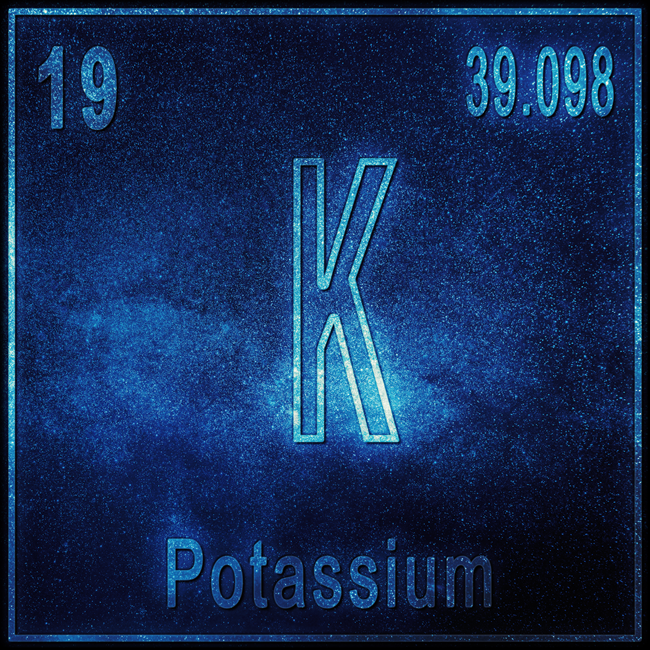Whilst I always suspected a direct link between potassium and thiamine deficiency (outside of the context of refeeding syndrome), I had not come across any direct research elucidating the mechanisms – until NOW. In short, thiamine deficiency causes intracellular potassium wasting.
Animal research in rats showed that chronic thiamine deficiency increases sodium tissue content in heart, liver and skeletal muscle by 18-35%, while also decreasing potassium content by 18-25%. Interestingly, although tissue levels were altered, plasma levels of these electrolytes remained unaffected and stayed within the normal-high range (sodium at 141.6 and potassium at 4.8). This means that blood measurements did not reflect tissue content.
The thiamine deficient group also displayed remarkably lower levels of stored liver glycogen (0.3gm/100 vs 2.7gm/100 in controls). This inability to store glycogen is one factor which helps to explain the strong tendency towards hypoglycemia seen in many people with a thiamine deficiency.
Interestingly, the researchers showed a shift towards an increased level of extracellular water and reduced intracellular water. This finding, along with the shift in intracellular electrolyte concentrations, is 100% consistent with Ling’s Association-Induction hypothesis.
In short, the bioenergetic state of the cell governs its ability to retain potassium ions and structure water into a gel-like phase. A cell with plentiful ATP can maintain this ability, independent of the “sodium potassium pump”. On the other hand, cells lacking energy lose their capacity to retain potassium, intracellular water becomes “unstructured” and intracellular concentration of sodium ions increases and the electronic state of the cell is changed. This causes water to “leak” out of the cells into the extracellular space to produce a localised edema of sorts. Thiamine, playing a central role in energy metabolism, is partially responsible for maintaining healthy redox balance and a continuous supply of ATP. Hence, it is no wonder why a deficiency of this essential nutrient produces such drastic changes in the cellular electrolyte balance.
Thiamine, TTFD, Potassium, and Heart Function
The cells of the heart are particularly susceptible to a disturbance in electrolytes. One Japanese study on coronary insufficiency in dogs showed elevated sodium and reduced potassium content in the insufficient left ventricle. Intravenous administration 50mg thiamine, in the form of thiamine tetrahydrofurfuryl disulfide (TTFD), a derivative of thiamine with higher bioavailability and solubility than other formulations, restored electrolyte balance, likely through improving tissue energy metabolism.
Likewise, the same effect was also demonstrated in isolated Guinea pig atria kept in potassium-free medium. TTFD added to cells or administered as a pre-treatment prevented the loss of potassium and increase in sodium, which was shown to occur in controls. Importantly, this effect was not achieved by thiamine HCL or another derivative studied. TTFD also entered the atrial cells much more readily than other forms, demonstrating its superior absorbability and perhaps suggesting that this form would be useful for addressing cardiac thiamine insufficiency.
Low potassium is a known driver of cardiac arrhythmias, and TTFD possesses anti-arrhythmic properties and has historically been used to treat various types of arrhythmia in Japan.
Furthermore, thiamine TTFD was also been shown to be protective against the cardiac toxin Strophanthin-G, preventing the loss of potassium once again to preserve cardiac function. Likewise, atrial cell damage through exposure to the mitochondrial toxin N-ethylmaleimide was also prevented by high concentrations of TTFD in-vitro. This protective action was attributed to the prosthetic group specific to TTFD, and NOT the thiamine molecule itself.
So it would seem that thiamine, probably through its effects on energy metabolism inside cells, and perhaps due to an unknown “kosmotropic” property of TTFD, is extremely important for regulating cell ion concentrations. In thiamine deficiency, an underlying intracellular potassium deficiency may be going unnoticed due to unremarkable blood levels. In cases where potassium deficiency is suggested, thiamine deficiency may be indicated, and TTFD might used to more safely correct the electrolyte balance.
We Need Your Help
More people than ever are reading Hormones Matter, a testament to the need for independent voices in health and medicine. We are not funded and accept limited advertising. Unlike many health sites, we don’t force you to purchase a subscription. We believe health information should be open to all. If you read Hormones Matter, like it, please help support it. Contribute now.
Yes, I would like to support Hormones Matter.
Image credit: Image by Allexxandar on Freepik.
This article was published originally on May 13, 2020.
















Just spitballing here, but…
Considering that thiamine plays a role in the activity of ATPases (sodium-potassium pumps and others), what could be going on is a redistribution effect. How do you know that you’re wasting potassium? Have you had a urinalysis to check for urine potassium excretion? The only way you waste K+ is thru your kidneys and GI tract (diarrhea mostly). Otherwise if your urine K+ is within normal range, what is causing your potassium to drop is not wastage, but redistribution back into cells. This will concomitantly raise your plasma sodium levels since the sodium-potassium pump is an antiporter (one ion goes to get one in). If the B1 is providing more energetic precursors to this enzyme, then its activity is going to increase and as a result, your cells will suck up more potassium and push out sodium versus when it is less active. This is all something to discuss with your physician but its worth mentioning.
This is fascinating, as I have dysautonomia after a TBI (specifically Orthostatic Hypotension and Postural Intolerance – not POTS), although I had symptoms of dyautonomia for my whole life, and am on an extremely high-sodium diet for it. I am to take at least 11g sodium a day (yes, sodium, not salt), and get as much potassium as I can from foods. But I have a lot of trouble getting that amount of sodium. When I try to balance it out with more potassium, I get very bizarre symptoms that even my cardiologist, who is a dysautonomia specialist, has never seen before.
My face gets very pale and yellowish, my eyes get puffy while the rest of my face sags – as if there’s no longer blood volume in it, and I get many neurolgical/cognitive symptoms – like lightheadedness, sensitivity to light and noise, inability to find words or speak properly. It’s essentially like I get concussed again, but with the weird facial symptoms. This occurs when I have potassium supplements or drinks like coconut water, but it also happens during/after stress, if I try and exercise or do heavy cognitive tasks, or postprandial.
After a bad reaction to some steroid injections, (that’s also a mystery because it lasted for many more months than it should have, and was really intense for the amount I had), I had all the symptoms of retaining sodium and wasting potassium, but my blood levels of both were fine. I had to go onto a restricted sodium diet to only 300mg/day before the swelling and cognitive symptoms subsided. It lasted 5 months. I asked my cardiologist about my intracellular potassium possibly being low, but she said “That’s not a thing.”
When I tried to start taking thiamine last week (benfotiamine 80mg), I started feeling like I was retaining sodium and wasting potassium again. I had some very strong side effects that indicated it (very weak, strong fatigue, mind blank, staring, can’t think or tolerate any stimulation beyond a dark/silent room, confusion – I couldn’t read a clock, muscle tension and twitching, temperature dysregulation – going from sweating which I usually don’t do to freezing every few minutes, one of the worst headaches of my life – it legitimately felt like my brain was swelling).
But it also was different from the steroid reaction though, so I’m not sure what electrolytes were off and in which direction. But the reaction was so strong I needed to stop until I could sort out the electrolytes it changes.
What would you recommend for someone in a similar position? I can try and lower my sodium and increase my potassium, but I’m not sure how much to, and as I’m at the upper limit of what potassium I can get from diet (~4000mg/day) so I would have to take supplements which I usually react to.
I also take a very good quality mutli (AOR Orthocore) with good amounts of bioavailable B complex and 300mg magnesium/day. I also consume 7L fluids a day with my high-sodium diet, so I really need to be careful with what I change and in what direction.
I would really like to try again, and have orderd some Thiamax, but the sudden electrolyte symptoms were very strong, so would need some help first before trying again. Any thoughts are appreciated.
Dear Drs Overton and Lonsdale,
I have been taking allithiamine (1000 mg/day) together with magnesium and multivitamin-mineral. For a long time that went well, but then I started getting bloating, red and itchy skin, as well as very dry and wrinkly skin and lightheadedness.
I then added B complex and potassium, based on what I have read on this site and Dr Overton’s site.
For a while this improved things, but then worse again. Then I stopped potassium, and it improved, but now it’s getting worse again, and if I add the potassium back in, it becomes even worse.
So I am really quite unsure now as to whether I should supplement potassium, or keep it out, especially since there are also articles about the danger of hyperkalemia.
Many thanks for your work!
Elliott:
The following excerpt is exactly TRUE in my case!!
Recently, I had lab work done and my potassium serum level tested mid-range at 4.2. I have been on 600mg of TTFD for 8 months including many co-factors experiencing significant dysautonomia symptoms improvement. Upon thoroughly studying Dr Lonsdale’s book I recently realized that I required potassium which I slowly over 2 months increased to 4700mg/day. As reached these levels I noticed rapid improvement in many symptoms such muscle weakness, significant improvement in energy as suddenly my diaphragm was working again which clearly increased oxygen transport from hemoglobin into mitochondria… importantly, this almost completely resolved slurred that I had for more than 2 years to the point that I was not comprehensible. There are a host of other symptoms being resolved that I will write about in an upcoming case report. I was blown away by the improvement I experience after 9 years of full blown beriberi. Dr Lonsdale description in the book of everything I experienced is in all aspects accurate and applied to me. For the first time I really understand!
Amazing work all of you!! I want to help and dedicate my life to spreading the information about this…. With much gratitude!!
“In short, thiamine deficiency causes intracellular potassium wasting.
Animal research in rats showed that chronic thiamine deficiency increases sodium tissue content in heart, liver and skeletal muscle by 18-35%, while also decreasing potassium content by 18-25%. Interestingly, although tissue levels were altered, plasma levels of these electrolytes remained unaffected and stayed within the normal-high range (sodium at 141.6 and potassium at 4.8). This means that blood measurements did not reflect tissue content.”
Would love to have you write up and share your case on HM.
Dr Marrs
I will gladly share my case. It will take me some time. Do you have specific guidelines as to format, requirements etc.? Finally, how do I submit it to you publishing?
Thank you!
Elliot Overton,
Your work is brilliant. I really appreciate the manner in which you relay the research evidences in detail and provide the big picture overview.
Without your works on YouTube and other platforms I very much doubt I’d have identified my thiamine deficiency. And with my doctor’s proving themselves worthless in not just diagnosis, but now with treatment, I wouldn’t have a chance in hell of figuring out how to treat myself without the educational resources you’ve provided.
I would encourage you to continue to produce content on whatever topics you research.
Can you recommend the brand of potassium supplement you use ?
After reading this post suggesting to not supplement K – https://www.hormonesmatter.com/should-you-supplement-potassium/ – (but it does not mention B1) and as I need and take both thiamin and potassium, AND as I have noticed I get dehydrated, I was wondering about the need to take more sea salt for Na when taking K!
Does my interrogation make sense ?
What would be the needed increase of Na in ratio to K and is there a way to feel it oneself?
I regulate my K intake according to having leg cramps in the morning or not.
I have just had a good response by going from 1 thiamax to 2, and my potassium needs seems to be the same. I also wonder about adding it to my daily water in order to spread it more during the day. Sea salt seems more adapted to take during meals because of the Cl, but I am not sure about this. There is little information in general about when to take minerals and vitamins, which to not take together, what to increase when increasing another one etc. K and Na seem to be a good example!
I enjoyed reading your post, Ellliot. I think that hypokalemia in thiamine deficiency is due to lack of ATP for the sodium/potassium membrane pumps. In fact. I believe that energy deficiency may be at the root of disease, period! Many years ago, I visited Hans Selye in Montreal. He described the General Adaptation Syndrome (GAS) as the energy requiring response to trauma and/or infection in animal systems. He believed that human diseases were “diseases of adaptation”, or failed GAS from lack of energy. Skelton, one of his students produced the GAS in an animal by inducing thiamine deficiency. Selye was convinced that we would be adapting his research to the practice of 21st century medicine. I believe that he was right but instead, he has been forgotten. I keep trying to revive him. Thiamine is a unique nutrient because of its many different functions in energy metabolism. Used as a “drug” in megadoses, or better still, as TTFD, it is capable of stimulating a return of mitochondrial function.
Absolutely fantastic! It’s so TRUE!
I am on 4th reading/studying of your book! I want to understand it front to back and back to front!
I also quit sugar completely on your advice which is also was a game changer!
I will write a case report as I promised you a while back.
Thank you so much for giving me my life back!!
Brilliant article. I did not know about Ling’s hypothesis and would like to look into it. But what you say matches with Emanuel Revici’s potassium utilization schema: anabolic-anaerobic-alkaline imbalances are associated with high cellular potassium, low serum potassium, low cellular hydration and high tissue water (edema), and catabolic-aerobic-acidic imbalances being opposite in shifts. Revici studied this extensively, but did not connect it to thiamine. But he did develop a highly accurate potassium-utilization test involving comparison of serum potassium to total-blood potassium, the latter as measured by the same serum-testing equipment, but using a 9:1 dilution of whole blood in distilled or deionized water. This brings the whole-blood potassium concentration (average 38 mEq/L) down into the serum-testing range, which needs only a shift in the decimal point to correct the units. Appreciate the article!
This is interesting. It’s something that I suspected (based only on empirical evidence), but wasn’t able to figure out. Could this explain in part, I wonder, why Covid-19 patients become very potassium-deficient, especially if they don’t supplement thiamine?
I think thiamine deficiency is at the root of many of the symptoms attributed to COVID, particularly with the hospitalized and more severe cases. Everything points to mitochondrial failure in the covid related deaths.
I wonder why it isn’t addressed more often? From what I have seen, the only Dr to mention it is Professor Marik…
And it appears he has removed it from the latest iteration of his protocol, at least a copy that I saw recently.
I am not sure why it isn’t addressed more frequently. I think most assume we solved it with food fortification, failing to realize that those types of foods tend to be more of a drain on thiamine than any fortification can overcome.
I just saw a recent interview with Dr. Marik and Dr. Mercola. I think the thiamine is still part of the protocol because after reading it (today – Apr 30, 2023), I went searching for this article which I had read a year ago.
Additional evidence: patients with Covid-19 disease often have a low oxygen saturation and a chest x-ray that reportedly “looks more like edema” both of which are found in thiamine deficiency. Furthermore, TD is found in patients with critical disease and following GI surgery. Unfortunately TTFD is “not approved” by the FDA and is not available I/V but IS available as Lipothiamine in tablets and as Allithiamine in powder form. O how I wish that this could be better known as a potential life saver in Covid-19!!!!